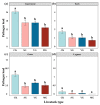Effects of Different Livestock Grazing on Foliar Fungal Diseases in an Alpine Grassland on the Qinghai-Tibet Plateau
- PMID: 37755057
- PMCID: PMC10533196
- DOI: 10.3390/jof9090949
Effects of Different Livestock Grazing on Foliar Fungal Diseases in an Alpine Grassland on the Qinghai-Tibet Plateau
Abstract
In grassland ecosystems, the occurrence and transmission of foliar fungal diseases are largely dependent on grazing by large herbivores. However, whether herbivores that have different body sizes differentially impact foliar fungal diseases remains largely unexplored. Thus, we conducted an 8-year grazing experiment in an alpine grassland on the Qinghai-Tibet Plateau in China and tested how different types of livestock (sheep (Ovis aries), yak (Bos grunniens), or both)) affected foliar fungal diseases at the levels of both plant population and community. At the population level, grazing by a single species (yak or sheep) or mixed species (sheep and yak) significantly decreased the severity of eight leaf spot diseases. Similarly, at the community level, both single species (yak or sheep) and mixed grazing by both sheep and yak significantly decreased the community pathogen load. However, we did not find a significant difference in the community pathogen load among different types of livestock. These results suggest that grazing by large herbivores, independently of livestock type, consistently decreased the prevalence of foliar fungal diseases at both the plant population and community levels. We suggest that moderate grazing by sheep or yak is effective to control the occurrence of foliar fungal diseases in alpine grasslands. This study advances our knowledge of the interface between disease ecology, large herbivores, and grassland science.
Keywords: alpine grasslands; community pathogen load; fungal diseases; herbivores; species richness.
Conflict of interest statement
The authors declare no conflict of interest.
Figures







Similar articles
-
Effects of yak and Tibetan sheep grazing on soil arthropods community in an alpine meadow on the Qinghai-Tibet Plateau, China.Ying Yong Sheng Tai Xue Bao. 2023 Nov;34(11):3127-3134. doi: 10.13287/j.1001-9332.202311.031. Ying Yong Sheng Tai Xue Bao. 2023. PMID: 37997424 English.
-
Symbiotic diazotrophs in response to yak grazing and Tibetan sheep grazing in Qinghai-Tibetan plateau grassland soils.Front Microbiol. 2023 Sep 6;14:1257521. doi: 10.3389/fmicb.2023.1257521. eCollection 2023. Front Microbiol. 2023. PMID: 37744903 Free PMC article.
-
Plant community-mediated effects of grazing on plant diseases.Oecologia. 2022 Aug;199(4):897-905. doi: 10.1007/s00442-022-05223-7. Epub 2022 Jul 30. Oecologia. 2022. PMID: 35907123
-
Animal board invited review: Grassland-based livestock farming and biodiversity.Animal. 2022 Dec;16(12):100671. doi: 10.1016/j.animal.2022.100671. Epub 2022 Oct 21. Animal. 2022. PMID: 36436479 Free PMC article. Review.
-
[Vegetation and soil characteristics of degraded alpine meadows on the Qinghai-Tibet Pla-teau, China: A review].Ying Yong Sheng Tai Xue Bao. 2020 Jun;31(6):2109-2118. doi: 10.13287/j.1001-9332.202006.002. Ying Yong Sheng Tai Xue Bao. 2020. PMID: 34494765 Review. Chinese.
References
Grants and funding
LinkOut - more resources
Full Text Sources

